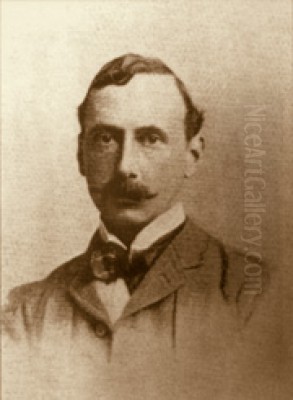
Herbert James Draper stands as a significant, if sometimes overlooked, figure in the landscape of late Victorian and early Edwardian art. A master of mythological scenes, sensuous nudes, and elegant portraiture, Draper's work captured the zeitgeist of an era fascinated by classical antiquity, romantic narratives, and the evocative power of the human form. His career, though relatively short, produced a body of work that continues to enchant and intrigue, demonstrating a unique fusion of academic precision with a rich, almost theatrical, sensibility.
Early Life and Artistic Formation
Herbert James Draper was born in London in November 1863. His father, John James Draper, was a prosperous jeweler, and his mother was Emma. This upbringing in a family with an appreciation for craftsmanship and aesthetics may have subtly influenced young Herbert's artistic inclinations. He received his early education at the Bruce Castle School in Tottenham, a progressive institution known for its broad curriculum.
His formal artistic training began at the prestigious Royal Academy Schools, a crucible for many of Britain's finest artists. Draper proved to be a talented student, winning a silver medal in 1887 for drawing from life. A pivotal moment in his early career was winning the Royal Academy Gold Medal and Travelling Studentship in 1889. This award provided him with £200 for two years, enabling him to further his studies abroad. Between 1888 and 1892, Draper embarked on several study trips, immersing himself in the artistic treasures of Paris and Rome. These journeys were crucial, exposing him to the masterpieces of Renaissance and Classical art, as well as the contemporary academic traditions flourishing on the continent, particularly the work of French masters like William-Adolphe Bouguereau and Jean-Léon Gérôme, whose polished classicism was highly influential.
The Rise of a Mythological Painter
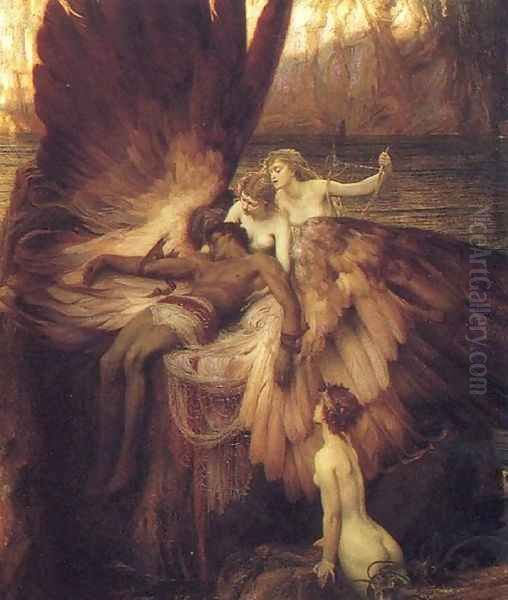
Upon his return to England, Draper initially undertook some illustration work, a common path for young artists seeking to establish themselves. He contributed to publications such as The Illustrated London News and The Graphic. However, his true passion lay in painting, particularly large-scale narrative compositions drawn from classical mythology and literature. The late Victorian era was a fertile ground for such themes, with artists like Lord Frederic Leighton, Sir Lawrence Alma-Tadema, and Sir Edward Poynter popularizing scenes from ancient Greece and Rome, often imbued with a romantic or sentimental quality.
Draper quickly distinguished himself within this milieu. His style, while rooted in academic tradition, possessed a vibrancy and sensuousness that set it apart. He was particularly adept at rendering the human form, especially the female nude, with a combination of anatomical accuracy and idealized beauty. His figures often exude a palpable vitality, their flesh tones luminous and their poses dynamic. This focus on the sensuous, sometimes verging on the erotic, was a hallmark of his mythological works, appealing to the Victorian appetite for classical subjects that allowed for a degree of tasteful nudity.
Masterpieces and Signature Works
Draper's reputation was firmly established with a series of powerful and evocative paintings. Among his most celebrated is The Lament for Icarus, exhibited at the Royal Academy in 1898. This poignant work depicts the fallen Icarus, his lifeless body cradled by sea nymphs, their sorrowful expressions contrasting with the beauty of their forms and the shimmering sea. The painting was an immediate success, lauded for its technical skill, emotional depth, and exquisite rendering of light and texture. It was purchased under the terms of the Chantrey Bequest for the Tate Gallery and later won the gold medal at the Exposition Universelle in Paris in 1900, cementing Draper's international standing.
Another iconic work is Ulysses and the Sirens, painted in 1909. This dramatic composition captures the hero Ulysses tied to the mast of his ship, resisting the alluring song of the Sirens who attempt to lure him and his crew to their doom. The painting is a tour-de-force of dynamic movement and psychological tension, with the seductive yet menacing Sirens contrasting sharply with the tormented Ulysses. Draper’s ability to convey narrative through powerful figural arrangements and expressive faces is fully evident here.
The Gates of Dawn (1900) is a more ethereal and allegorical piece, depicting Aurora, the Roman goddess of dawn, opening the gates for the sun god Apollo. The painting is notable for its luminous palette and the graceful, flowing lines of Aurora's figure, embodying the hope and renewal associated with the dawn. It showcases Draper's skill in creating a dreamlike, poetic atmosphere.
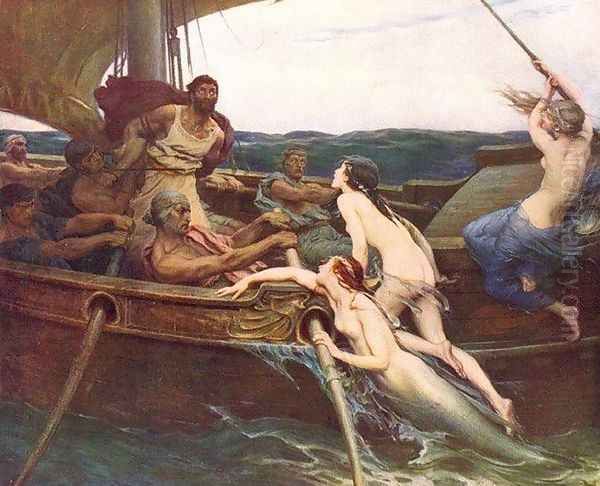
Other significant mythological paintings include The Sea Maiden (1894), an early success that features a beautiful nymph reclining on a rock, her form intertwined with seaweed, and Ariadne (1905), depicting the Cretan princess abandoned on the island of Naxos. The Pearls of Aphrodite (1907) is another notable work, showcasing his ability to render opulent textures and the allure of the goddess of love. Clytie (c. 1900s), depicting the nymph who, spurned by Helios, transforms into a sunflower, is another example of his engagement with Ovidian myths of transformation and unrequited love.
Draper also explored themes from British legend, as seen in Lancelot and Guinevere (c. 1890s), capturing a moment of romantic intensity from Arthurian lore, a subject popularised by Pre-Raphaelite artists like Dante Gabriel Rossetti and Edward Burne-Jones.
Style, Technique, and Influences
Draper's artistic style is a fascinating amalgamation of various influences. The rigorous training of the Royal Academy Schools provided him with a strong foundation in draughtsmanship and composition, hallmarks of the academic tradition. His studies in Italy and Paris further refined his classical sensibilities. However, his work also bears the imprint of the Pre-Raphaelite movement, particularly in its attention to detail, rich colour palette, and romantic subject matter. Artists like John William Waterhouse, a contemporary who also specialized in mythological and literary themes, shared a similar aesthetic terrain, blending classical subjects with a Pre-Raphaelite intensity of feeling and colour.
Draper's handling of paint was fluid and confident. He excelled at depicting textures – the smoothness of skin, the sheen of silk, the iridescence of water, and the roughness of rock. His use of light was often dramatic, highlighting key figures and creating a sense of depth and atmosphere. His compositions were carefully constructed, often employing dynamic diagonals and complex groupings of figures to enhance the narrative impact.
While primarily known for his mythological scenes, Draper was also an accomplished portraitist. He became a member of the Royal Society of Portrait Painters in 1911 and later served as its President. His portraits, often of elegant society women, display the same sensitivity to form and character evident in his narrative works. He also undertook decorative commissions, most notably the ceiling decoration for the Drapers' Hall in London, a fitting commission given his surname, though there is no direct familial connection to the Drapers' Company. This work, depicting mythological and allegorical figures, showcases his ability to work on a grand scale and integrate his art within an architectural setting, much like his contemporary Frank Dicksee, who also undertook large decorative schemes.
The Artistic Milieu: Contemporaries and Connections
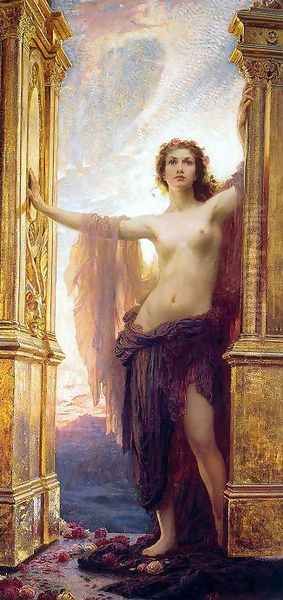
Herbert James Draper operated within a vibrant and diverse British art world. The late 19th and early 20th centuries saw the continuation of High Victorian art alongside the emergence of new movements. The influence of the Pre-Raphaelite Brotherhood, founded by William Holman Hunt, John Everett Millais, and Dante Gabriel Rossetti, was still palpable, particularly in its later phases as championed by Edward Burne-Jones and William Morris. Their emphasis on literary and medieval themes, detailed naturalism, and rich colour resonated with many artists, including Draper.
The dominant force in official art circles was Academic Classicism, epitomized by figures like Lord Frederic Leighton, President of the Royal Academy. Leighton’s polished, idealized depictions of classical subjects set a high standard for mythological painting. Sir Lawrence Alma-Tadema, with his meticulously researched and beautifully rendered scenes of everyday life in ancient Greece and Rome, was another hugely popular figure. Sir Edward Poynter, who succeeded Leighton as President of the Royal Academy, also contributed significantly to the classical revival.
John William Waterhouse was perhaps Draper's closest contemporary in terms of subject matter and style. Both artists specialized in mythological and literary themes, often featuring enigmatic and alluring female figures. Their works share a romantic sensibility and a rich, jewel-like palette. While Draper's figures often possess a more robust physicality, Waterhouse's tend towards a more ethereal, melancholic beauty.
Other notable contemporaries included George Frederic Watts, whose symbolic and allegorical paintings explored profound themes of life, death, and human destiny. Albert Moore, associated with the Aesthetic Movement, created harmonious compositions of classically draped female figures, focusing on formal beauty rather than narrative. Solomon J. Solomon was another contemporary known for his dramatic historical and mythological scenes, as well as his society portraits. The slightly older Ford Madox Brown, though more aligned with the earlier phase of Pre-Raphaelitism, continued to be an influential figure with his morally charged historical paintings.
Draper, while not a radical innovator, skillfully navigated these artistic currents, forging a distinctive style that appealed to both academic tastes and popular sentiment. He regularly exhibited at the Royal Academy from 1887 onwards, though he was never elected a member or an associate, a somewhat surprising omission given his success and the quality of his work. This lack of formal RA membership might have contributed to his later relative obscurity compared to figures like Leighton or Waterhouse.
Later Career, Legacy, and Reappraisal

Draper's most productive period was arguably from the mid-1890s to the late 1900s. During this time, he produced many of his most famous works and enjoyed considerable critical and popular acclaim. His paintings were sought after by collectors and reproduced in popular art journals.
However, the early 20th century witnessed a seismic shift in artistic tastes. The rise of modernism, with its emphasis on abstraction, experimentation, and a rejection of academic conventions, led to a decline in the popularity of narrative and classical painting. Artists like Draper, whose work was firmly rooted in 19th-century traditions, found their reputations waning. By the time of his death in September 1920, at the relatively young age of 56, the art world was a very different place.
For much of the 20th century, Draper, like many of his Victorian contemporaries, was largely overlooked by art historians and critics. His work was often dismissed as sentimental, overly academic, or outmoded. However, the late 20th and early 21st centuries have seen a significant reappraisal of Victorian art. Scholars and collectors have begun to recognize the technical skill, imaginative power, and cultural significance of artists like Draper.
His paintings now command high prices at auction, and his work is increasingly featured in exhibitions and publications on Victorian art. The Lament for Icarus remains a popular and iconic image, widely reproduced and admired. The renewed interest in Draper's art reflects a broader appreciation for the diversity and richness of the Victorian artistic achievement. His ability to imbue classical themes with a sense of drama, sensuality, and psychological depth ensures his enduring appeal.
Draper's influence on subsequent artists is perhaps less direct than that of more avant-garde figures. However, his commitment to craftsmanship, his mastery of the human form, and his imaginative engagement with mythology provide a compelling example of a particular strand of late classical painting. His work serves as a reminder of the enduring power of narrative art and the timeless allure of classical myths.
Conclusion: An Enduring Vision
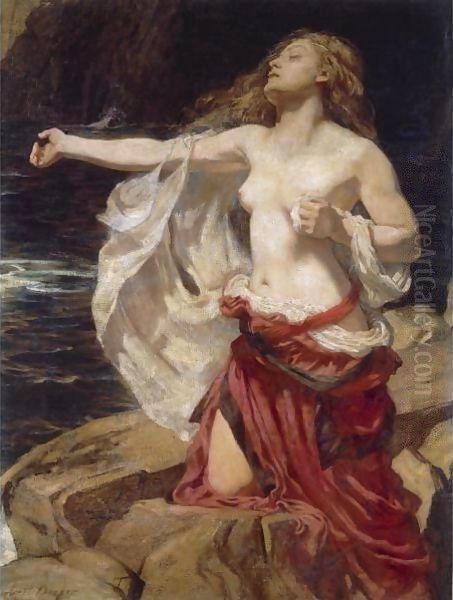
Herbert James Draper was a painter of considerable talent and vision. He navigated the complex artistic landscape of late Victorian and Edwardian Britain with skill and individuality, creating a body of work that is both a product of its time and possessed of a timeless appeal. His mythological paintings, in particular, stand as powerful testaments to his imaginative power, his technical virtuosity, and his ability to evoke the drama, passion, and beauty of the ancient world.
While his fame may have been eclipsed for a time, the resurgence of interest in his work is a testament to its enduring quality. Draper's paintings continue to captivate viewers with their sensuous figures, rich colours, and compelling narratives. He remains a key figure for understanding the multifaceted nature of British art at the turn of the 20th century, a skilled classicist who infused academic tradition with a distinctly romantic and vibrant sensibility. His legacy is that of an artist who, at his best, could transport the viewer to a world of myth and legend, rendered with breathtaking skill and profound feeling.